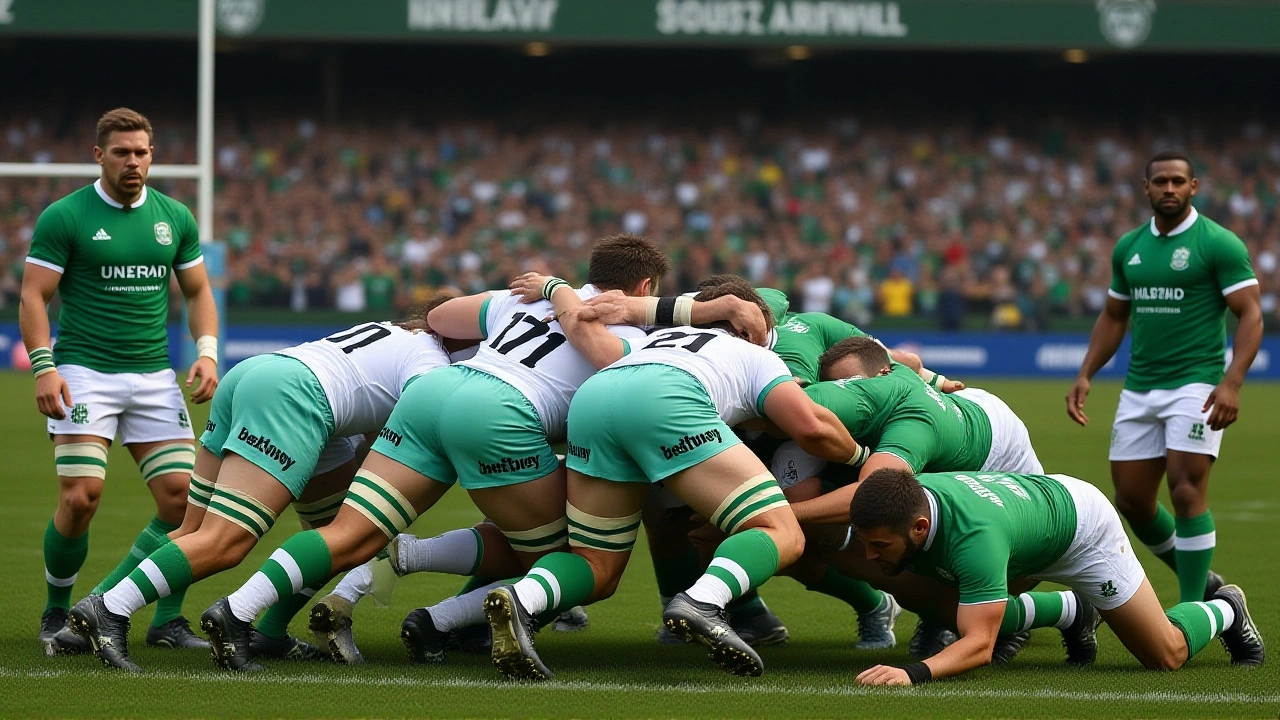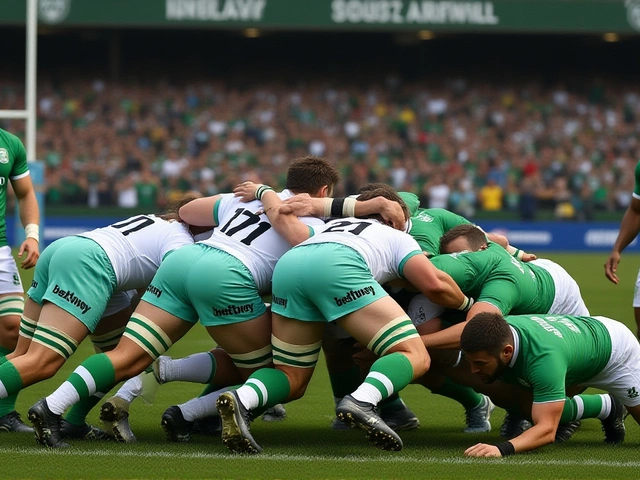When the final whistle blew at the Aviva Stadium on Saturday, November 22, 2025, the roar wasn’t just from South African fans—it was the sound of history being rewritten. The South Africa national rugby union team, the Springboks, crushed Ireland 24-13 in a match that turned chaotic, physical, and unforgettable. It wasn’t just a win—it was their first in Dublin in 13 years, ending a drought that stretched back to 2012. And it came at a cost: Ireland, already bruised, were reduced to 12 men for large stretches, their discipline unraveling under pressure.
A Match That Unraveled
The first half didn’t just set the tone—it shattered it. By the 25th minute, James Ryan, Ireland’s towering lock and defensive anchor, was sent off for a dangerous clearout. Then came the yellow cards: four in total, all on Irish players. At one point, Ireland had only 12 men on the field for over 40 minutes. The Springboks didn’t need to score constantly—they just needed to hold the line and wait. And when Ireland’s scrum collapsed under the weight of South Africa’s relentless push, the penalty try arrived. That six-pointer, awarded after repeated infringements against Andrew Porter and Paddy McCarthy, was the turning point.
South Africa’s points came from precision and power: Damian Willemse crossed early, Cobus Reinach added a slick break after a turnover, and Sacha Feinberg-Mngomezulu sealed it with a late try. Ireland’s lone response? A powerful finish by hooker Dan Sheehan in the 22nd minute. But with the sin bins filling up and the crowd’s energy draining, the lead slipped away.
Erasmus Finally Wins in Dublin
For Rassie Erasmus, South Africa’s head coach, this was personal. He’d lost in Dublin before—twice as director of rugby, once as head coach. This time, he walked off with his first victory at the Aviva Stadium. "We knew it would be tough," Erasmus said post-match, according to RugbyPass. "But when you’re down to 12 men, you either fold or fight. Ireland fought. We just had more in the tank."
The contrast couldn’t be starker. Ireland, under Andy Farrell, entered the match as world-ranked #2, riding high after a gritty win over New Zealand. But the discipline issues—four yellow cards, one red—were the kind that haunt teams for months. "We gave them too many gifts," Farrell admitted after the game. "You can’t play against the best in the world and hand them 14 points from penalties and red cards. It’s not a team issue. It’s a mindset issue."

The Boks’ Dominance, and the Questions It Raised
South Africa didn’t just win—they reminded everyone why they’re back-to-back world champions and the top-ranked team on earth. Their scrum, once their Achilles’ heel, was a battering ram. Their defense, disciplined even when outnumbered, held firm. And their set-piece execution? Flawless under pressure.
But here’s the twist: they didn’t capitalize. Despite dominating territory and possession in the second half, the Springboks missed three clear try-scoring opportunities. "They had three chances to put it away at 17-13," noted The Independent. "If they’d taken them, this would’ve been a 40-point rout. Instead, they let Ireland stay alive. That’s the worry."
For Ireland, the defeat was more than a loss—it was a reckoning. Their lineout was sloppy. Their breakdown work was slow. Their discipline? Nonexistent. And with the Six Nations looming in February, questions are mounting. Can Farrell fix this before the tournament? Can his younger players handle the pressure? Or is this the beginning of a decline?
A Rivalry That’s Growing Teeth
This wasn’t just another Autumn Nations Series fixture. It was the fourth chapter in a rivalry that’s moved from Paris to Pretoria, from Durban to Dublin. The stakes are rising. The intensity is spiking. And the outcomes? Unpredictable.
For South African fans, the match was broadcast live on SuperSport at 7:40pm SAST—the penultimate game of their European tour. For Irish viewers, it was a sobering night. The stadium was sold out. The atmosphere was electric. And when the final whistle came, silence followed.

What’s Next?
South Africa heads into their final tour match against Italy with confidence. They’ll likely rest key players, but the message is clear: they’re still the standard-bearers. For Ireland, the next 10 weeks are critical. They’ll need to rebuild their discipline, reassert their identity, and find leadership beyond their aging core. The Six Nations won’t wait.
Meanwhile, the Quilter Nations Series 2025 ends with a thud for Ireland—and a roar for the Springboks. The rivalry? Far from over. But the balance of power? It just shifted.
Frequently Asked Questions
Why did Ireland get so many yellow cards?
Ireland’s disciplinary issues stemmed from desperation and poor breakdown technique. With South Africa’s physicality overwhelming their forwards, Irish players resorted to late tackles and collapsing rucks to slow play. Four yellows and one red—especially James Ryan’s dangerous clearout—highlighted a breakdown in discipline under pressure, something coach Andy Farrell has struggled to correct since the 2023 World Cup.
How significant is South Africa’s win in Dublin?
Extremely. Before this match, South Africa hadn’t won in Dublin since 2012—a 13-year drought that included three losses and a draw. The Aviva Stadium has been a fortress for Ireland, especially against top-tier teams. This victory not only breaks that streak but also proves the Springboks can win away from home under extreme pressure, reinforcing their status as world champions.
What role did the scrum play in the outcome?
The scrum was decisive. South Africa’s pack, led by Pieter-Steph du Toit and Steven Kitshoff, consistently won penalties and forced Ireland’s front row into errors. That pressure led directly to the penalty try and two yellow cards for Andrew Porter and Paddy McCarthy. Ireland’s scrum, once a strength, was outclassed—losing four of six engagements and conceding five penalties in the first half alone.
Who were the standout players for South Africa?
Damian Willemse, at fly-half, controlled the game with his kicking and vision, while Cobus Reinach’s offloads and pace created two key tries. But the real hero was lock Siya Kolisi, who led by example with 18 tackles and a crucial turnover in the 65th minute. His leadership kept the Springboks composed despite Ireland’s numerical advantage in the second half.
Is this a sign of Ireland’s decline?
Not necessarily, but it’s a warning. Ireland still have elite talent—Sheehan, Murray, and Garry Ringrose showed flashes. But their lack of depth in the forward pack and recurring discipline issues suggest they’re vulnerable against physically dominant sides. If they don’t fix their breakdowns and decision-making by February, their Six Nations title hopes could collapse.
What’s next for the Quilter Nations Series?
The 2025 series is complete. South Africa’s final match was against Italy, which they won 41-10. Ireland’s next international fixture is against Wales in the Six Nations on February 1, 2026. The series, rebranded from the Autumn Internationals, is now a key preparatory platform for the World Cup cycle, and this result will heavily influence team selections for next year’s tournament.






Post A Comment